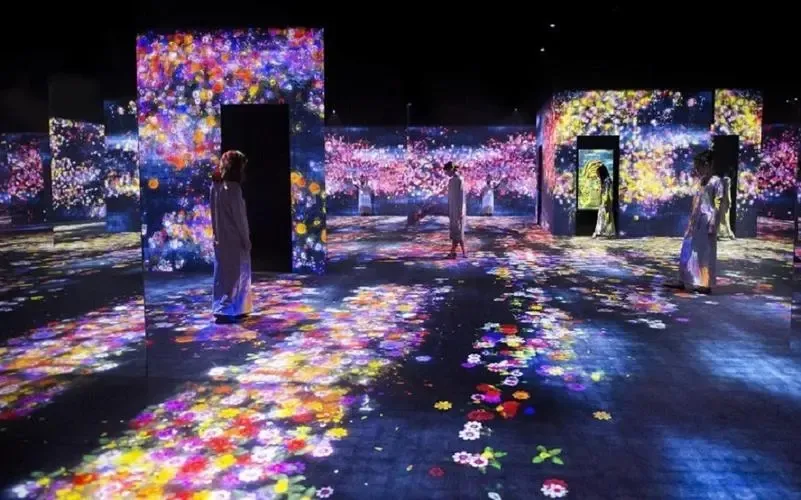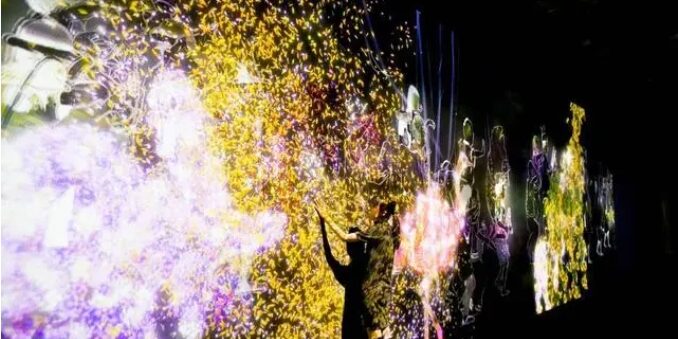In recent years, multimedia interactive technology has become an essential part of modern exhibition hall designs. As the complexity of exhibition systems increases, a remarkable innovation has emerged: wall-based interactive recognition systems. These systems integrate motion sensing, signal processing, and content display into one, creating an immersive experience that enhances the way visitors interact with exhibits. By leveraging cutting-edge technologies like infrared, radar, and LiDAR, these systems can recognize audience interactions and deliver dynamic, real-time content.
This article will explore how LiDAR interactive projection technology is revolutionizing digital exhibition halls, offering an immersive, engaging, and innovative experience for visitors.

The Rise of Interactive Exhibitions: Innovation at its Core
Interactive exhibitions are changing the way we experience museums, galleries, and trade shows. Traditionally, exhibits relied on static displays to convey information. However, with the advent of digital technology, walls are no longer just surfaces for displaying information—they have become dynamic, interactive spaces that respond to visitors in real-time.
LiDAR (Light Detection and Ranging) technology, when applied to wall-based interactive projection systems, is at the forefront of this revolution. By sensing and tracking the visitor’s gestures and movements, LiDAR-enabled systems can create personalized, engaging content that dynamically responds to each individual’s actions. Whether through touch, gesture control, or proximity sensing, the ability to interact with the wall as part of the exhibition adds a unique, immersive layer to the visitor experience.

Immersive Experience: Elevating Engagement with LiDAR Technology
LiDAR technology provides precise, real-time sensing capabilities that enable highly interactive and engaging displays. These interactive systems are capable of converting physical gestures and actions into meaningful digital responses, including the projection of images, videos, sounds, and even 3D models.
For example, when a visitor interacts with a LiDAR-equipped wall, the system can detect their presence and movements. The projected content on the wall can change or evolve based on these interactions, creating an environment where visitors actively participate in the exhibition. This dynamic interaction is not only engaging but also enhances the educational and entertainment value of the exhibition, making it memorable for visitors of all ages.
Key Advantages of Wall LiDAR Interactive Projection Systems
- Enhanced Visitor Engagement The integration of LiDAR technology with interactive projection offers an entirely new level of engagement. Unlike traditional displays, which require the visitor to remain passive, LiDAR-based systems allow visitors to engage with the content actively. Through hand gestures or body movement, the audience can trigger different layers of content, bringing the exhibit to life. This kind of interaction not only attracts attention but also encourages deeper exploration, making the experience much more enriching.
- Versatility of Digital Content Display The power of LiDAR interactive walls lies in their versatility. The system can support a wide range of content, including videos, images, text, and audio, which can be easily customized to suit different themes or topics. For instance, in a historical exhibit, visitors can touch a wall to trigger a 3D representation of a famous landmark or historical figure, with detailed descriptions and videos that enhance understanding. This diverse media integration ensures that visitors of all backgrounds can engage with the exhibit in a way that suits their interests and needs.
- Personalized and Tailored Experiences Wall LiDAR systems can offer a personalized experience by tailoring the content to the individual visitor’s actions. As a visitor interacts with the wall, the system can use data from sensors to create a custom experience based on their preferences. Whether it’s adjusting the difficulty level of interactive games, displaying specific product information, or guiding the user through a curated path, the potential for personalized experiences is vast.
- Customization and Aesthetic Integration The beauty of LiDAR-based interactive projection systems is their ability to seamlessly integrate with the aesthetic design of an exhibition. The system can be customized to fit the architectural style of the space, ensuring that it complements the overall design. Whether it’s for a sleek, modern gallery or a more traditional museum, the technology adapts to the environment, enhancing the visual appeal of the exhibit.
- Energy Efficiency and Sustainability In an era where sustainability is key, LiDAR interactive systems stand out for their energy efficiency. Unlike traditional LED displays that consume significant power, wall projection systems, especially those using LiDAR, offer a greener alternative. The technology ensures high light utilization, reducing energy consumption without compromising on the quality of the visual experience. This makes it an eco-friendly option for large-scale exhibitions.
Real-World Applications of LiDAR Interactive Walls
- Museum and Art Exhibitions In museums, LiDAR-based interactive projection systems can transform traditional exhibits into immersive, hands-on experiences. Visitors can engage with the art by physically interacting with the walls, triggering animations or detailed visual explanations of the artwork’s history or context. These systems can even allow visitors to “step into” the artwork, bringing elements of the painting or sculpture to life through projection and motion tracking.
- Trade Shows and Product Launches Trade shows and product launches can benefit from LiDAR interactive projection technology by creating highly engaging booths. Instead of traditional product displays, companies can use LiDAR walls to provide real-time interactive experiences for attendees. Visitors can touch, swipe, or gesture to explore features of products, view demonstrations, or even engage in interactive games that showcase the brand’s values and products.
- Corporate Showrooms and Presentations For businesses, LiDAR interactive systems can elevate showrooms and corporate presentations. By using these systems, companies can engage clients in a fully interactive product demonstration. Visitors can experience the product’s features through a series of engaging, interactive touchpoints—enabling deeper understanding and improving the overall customer experience.
Future of LiDAR Interactive Walls in Exhibition Design
The future of LiDAR-based interactive projection systems in exhibition design looks promising. As technology continues to evolve, these systems will become more intuitive and immersive, with even greater integration of AI, augmented reality (AR), and virtual reality (VR). This will further enhance the visitor’s engagement, providing a truly immersive experience where physical and digital worlds seamlessly merge.
Exhibition spaces will evolve into interactive environments where visitors can not only view but also become an active part of the story, contributing to a dynamic, personalized, and unforgettable experience.
Conclusion
In conclusion, wall LiDAR interactive projection systems are setting a new standard for immersive exhibitions. With the ability to engage audiences dynamically, provide personalized experiences, and enhance the overall quality of the exhibition, these systems are reshaping how we interact with digital content in exhibition halls.
As these technologies continue to advance, we can expect even more innovative applications in diverse fields, from museums to trade shows, and beyond. The future of interactive exhibitions is here, and it’s powered by LiDAR.
CPJROBOT specializes in the development and manufacturing of LiDAR technology and intelligent robots. Our cutting-edge solutions bring a new level of interactivity to exhibitions, offering customizable experiences for clients across various industries. If you’re ready to take your exhibition to the next level, contact CPJROBOT today to explore our innovative LiDAR solutions!







